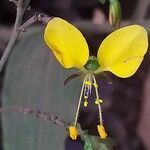Perennial herb, 0.3-1.0 m high, decumbent with ascending or straggling shoots. Leaves distichous, sheaths sticky, basal leaves petiolate, lanceolate to ovate, 35-165 x 10-50 mm, apex acute to acuminate. Inflorescence mostly terminal, with 2-7 alternate, opposite or whorled cincinni. Flowers: petals paired, yellow. Stamens with bearded filaments. Ovary: style 11-21 mm long, purple. Flowering time Dec.-May. Fruit an oblong-elliptic capsule, trilocular or bilocular; dorsal locule 1-seeded or empty, ventral locule 2-or 3-seeded. Seeds ovate to subquadrate; testa brown, shallowly foveolate-reticulate.
A herb. The stems are soft and weak. They can be trailing. There are many hairs. The leaves have large loose sheaths 2.5 cm long. The leaves are sword shaped and 12 cm long by 4 cm wide. The flowering arrangement is loosely branched. The flowers are yellow and 15 mm long. The fruit are 8 mm long. The surface has very fine beads.
Decumbent, perennial herb with ascending or straggling shoots. Leaves distichous. Inflorescences with 2-7 cincinni, puberulous. Sepals puberulous. Lateral stamen filaments bearded. Stems and sheaths often sticky because of presence of hooked hairs. Flowers yellow.


